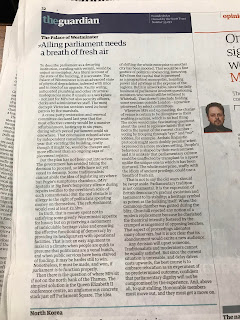COMPARING EDITORIAL COMMENTS
The Guardian
The Daily Mail
Similarities
Both articles use a small masthead, this helps the reader to identify the editorial comment section easily, and helps to separate it from the rest of the articles in the newspaper. Both also choose to write their articles in column style, all text based, with no images to accompany it. As well as this, both newspapers use an authoritative and persuasive tone; this helps the publisher to get their point across to their readers, spreading their opinion. Though, in either newspaper, this doesn't come across as too upfront as the readers of each newspaper already agree with the ideologies of the paper.
The editorial comments in both newspapers use subheadings, these are shown separate to the rest of the copy, helping to outline the opinion of the following article. Similarly, all the comment sections which the Daily Mail and the Guardian write are on current affairs. This appears to the audience of each paper as they are able to read an opinion which they are likely to agree with, on an affair which is currently in the media. Finally, both newspapers always include two or three different comment articles; in the examples above, the Mail has three separate articles, and the Guardian includes two.
Differences
The main difference between the Daily Mail and the Guardian's editorial comments are the topics which are covered. From looking at the examples above, the topics which the Daily Mail cover are insignificant compared to which the Guardian look at. In the examples above, the Mail cover the issue on bin collections in the UK, compared to the Guardian's article on nuclear war. With these articles, the language used between the two newspapers can also be compared. The Daily Mail's editorial comment uses much more descriptive language; verbs such as 'suffer' and 'festooned' are included, this use of hyperbole helps the more insignificant topics which the Mail cover, seem more significant to the reader. Readers of the Daily Mail, are often lesser educated compared to the target audience for the Guardian; hence the use of exaggeration can be overlooked as the reader is likely to agree with any article which is published in the editorial comment section.
Whereas the Guardian's use of a much wider vocabulary range, allows the more educated audience to understand the article in more detail - though without the use of exaggeration. For example, the topic of nuclear war is, in my opinion, much more valid than the issue of bin collections. The article above uses verbs like 'possess' and phrases like 'tempted down that disastrous road.' Here, the Guardian's use of language techniques like metaphors help the reader to understand how the publisher is expressing that North Korea is making rational decisions.
As well as this, the Daily Mail presents a completely bias article; whereas the Guardian, even though it shows slight bias throughout, is more informative - giving the reader a wider understanding on the topic.
Uses & Gratification Theory
This idea of 'active readers' helps newspapers, like the Daily Mail and the Guardian, to maintain reader figures, keeping them entertained with the articles included. All the daily editions of a newspaper follow the same ideologies, these are commonly the same as the reader who is choosing to read that specific paper. Unlike other areas of the media, newspapers force readers to be active with their choices as they have to go out and buy that particular newspaper which they feel follows the same ideologies as them. These ideologies become even more prominent within the editorial comment sections, as these are written by the editor of the newspaper. Therefore the articles are written from the perspective of the straight view o the entire paper, almost wrapping all the viewpoints of that ideology into a few single articles.
The Daily Mail satisfies the audiences need for entertainment, whereas the Guardian has almost the opposite approach. Though this difference fits with the target audience of each paper, and so neither newspaper is disadvantaged compared to the other. The Daily Mail covers more stories relating to the entertainment industry, though also entertains its adults readers with its use of hyperbole and bias within its articles. This sarcastic approach to its articles helps to identify more personally with the readers, often making what are serious news topics ore light-hearted and less meaningful.
Oppositely, the Guardian provides a highly level of education within its news stories compared to the Daily Mail. For instance, even the topics covered by the two papers make it very clear that the level of education is different. The examples above show this idea perfectly, with the Guardian involving an article on nuclear war, compared to the Daily Mail writing about the issue of bin collections. The Guardian's informative style helps to make sure the reader is fully informed on the relevant and needed details within each article. However the Mail, even when covering the same news story, includes irrelevant information, taking the focus away from the main event.
Newspapers can create social interactions by the articles and comments which they include within their editions. For example, by including articles that their readers have interest in; readers will be automatically be more engaged, therefore are more likely to take an active approach to what they are reading.






Comments
Post a Comment